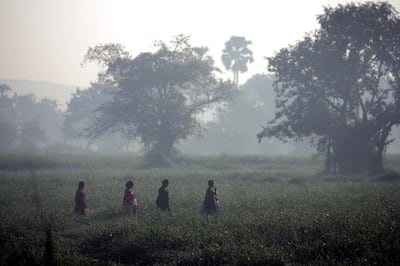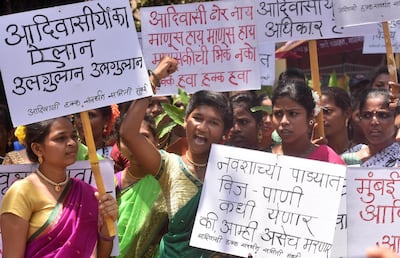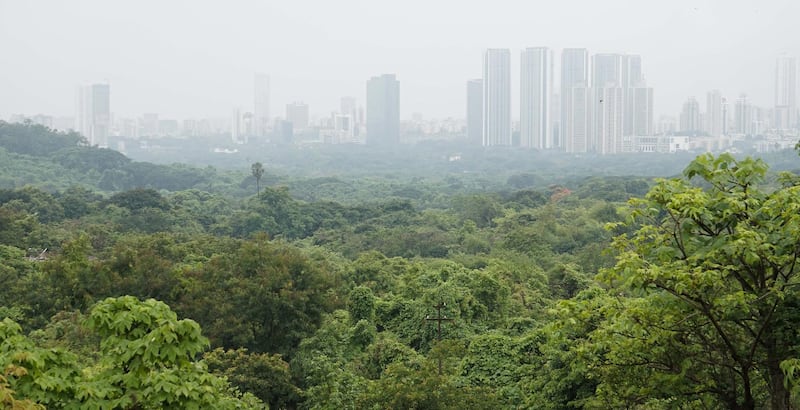Asha Bhoye has lived her whole life among dense forest in the otherwise metropolitan city of Mumbai. As far as she knows, at least three generations of her family, tracing back over a century, have occupied a small, quickly depleting, yet dense, patch of jungle in the heart of India’s commercial capital.
“We lived here before you could call this city a city,” she says.
But a new project by Mumbai Metro Rail Corporation Limited to build a metro line for the rapidly growing city threatens to destroy large parts of the Aarey Colony, the forest land that Ms Bhoye, 43, and other tribals call home.
The urbanisation project will require the felling of over 2,700 trees in the Aarey Colony forest, which will affect the tribal groups living in those lands, as well as the local wildlife, flora and fauna, all to build a train shed.
“I live in Prajapur pada in Aarey, and there are 27 padas that are home to over 1,000s people,” she estimated. Pada is a Marathi word for hamlet.
According to official counts, there are over 9,000 tribal people living in forest land that currently covers over 1,200 hectares of the city’s land. The proposed metro shed threatens to claim over 33 hectares of this area.
Several civil and political groups have come forward over the past five years to support efforts by the local tribes to protect their land against urbanisation. However, in recent months the campaign has taken on a sense of urgency as work on the Mumbai Metro project has begun, despite protests against it.

“I have already lost about 15 trees as well as land to their indiscriminate construction. I have lost parts of my orchard and trees that help support my family,” said Ms Bhoye, who like many in her tribe depend on the land for sustenance. They grow fruit and vegetables, the excess of which they sell.
The Forest Rights Act, a law from 2006, granted tribal groups a legal claim over that has helped them delay some of the urbanisation projects. However, threats from the metro project continue to loom.
As well as endangering a way of life for the forest’s indigenous population, local wildlife, including an endangered species of leopards, is also suffering.
“While the tribal people are losing their homes and livelihood due to this project, and other similar projects, increasing human activity in this area will also result in more human-animal conflict. The animal often pays for this with its life,” said Yash Marwah, an activist from Let India Breathe, one of the many organisations participating in protests against the felling of trees for the metro project.
In Sanjay Gandhi National Park, which lies next to the Aarey Colony and is essentially a natural extension of the forest, there are close to 47 adult leopards and about nine cubs, according to a 2018 survey. There are no borders between where the humans and animals live, meaning leopards can frequently be spotted in Aarey.
The colony itself is home to 76 species of birds, 86 species of butterflies, 13 species of amphibians, 38 different types of reptiles, 19 spider species and 34 different types of wild flowers.
“We have lived in harmony with nature so far. The trees they are cutting, I have nurtured them like my children. They provide clean air, homes for the animals and many of the plants are herbal and used for medicinal purposes,” Ms Bhoye said.

Locals have already noticed the impact of the new projects on the environment. Mr Marwah agreed, pointing out that the train shed project is also being built on the catchment area of the Mithi river, which could cause frequent flooding due to deforestation.
“The frequency and intensity that they are cutting the trees at is dangerous to us and the environment. The ecosystem is already changing noticeably and that is not good. It will affect the health of residents,” said Ms Bhoye.
“The government’s own expert committee has suggested alternatives and the shed could be located at Kanjurmarg (an eastern suburb of the city). Mumbai need not lose its precious lungs.”
The protest movement against the development includes several grass roots organisations, such as Let India Breath, as well as several political entities. It has grown organically over the last five years as Mumbai citizens have come forward in large numbers to support the cause. Some have crowded court rooms during hearings related to the case, and gathered in their thousands to save the land.
“We are seeing multiple layers here,” observed Aditya Paul, a member of the Aam Aadmi Party, a relatively new political party formed by former activists. “One part, which is visible in the media, is the mobilisation of the middle class and environmentalists who want to conserve what is an important biodiversity hotspot.
“Yet it goes beyond that – a large and important section of those fighting are the adivasis, or tribal people, who live in the 27 hamlets in Aarey. They want to protect a way of life that is intrinsically connected to conserving the forest.”
Last week, despite pouring rains and floods, over 500 people showed up to protest at the office of Mumbai Metropolitan Region Development Authority, the body overlooking city’s infrastructure. Government officials also admitted that they received over 82,000 emails from people registering complaints against the felling of trees.
While voices of discontent reverberated around the packed government auditorium, Ms Bhoye’s voice echoed the strongest. “Why does your development have to result in us losing our homes, livelihood and the environment?” she said, frustration ringing in her voice.
Government officials requested a 20-day period for deliberations. They will announce their decision by the end of the month.
While Ms Bhoye and other activists wait nervously, they continue to hold on to hope and have doubled down on their campaigns. “This is our home,” she said.
“We have to fight for it, we have no where else to go.”






